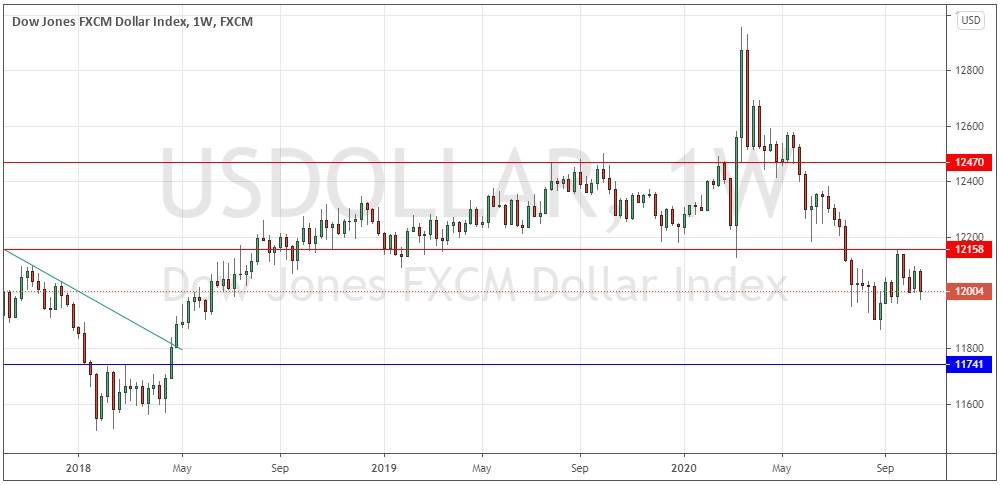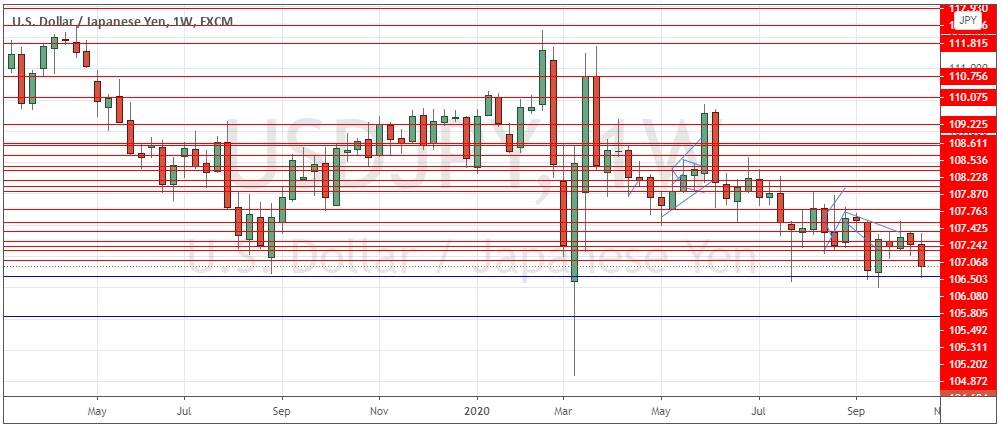The difference between success and failure in Forex trading is very likely to depend mostly upon which currency pairs you choose to trade each week and in which direction, and not on the exact trading methods you might use to determine trade entries and exits. The current market environment remains one of contradiction, with a questionable rebound as global stock market indices recovered to reach new all-time highs before correcting, despite the continuing spread of the coronavirus pandemic which is still sweeping the world.
Big Picture 25th October 2020
In my previous piece last week, I saw the most attractive trade opportunities as likely to be in short-term short trades in the USD/JPY currency pair. This was a good call as the USD/JPY currency pair ended the week down by 0.66%
Last week’s Forex market saw the strongest rise in the relative value of the New Zealand Dollar and the strongest fall in the relative value of the U.S. Dollar.
Fundamental Analysis & Market Sentiment
The focus now of stock market analysts in the U.S. is centered mostly upon the issue of progress towards a deal between House Democrats and the Trump administration on a further round of economic stimulus which is widely seen as necessary to reignite economic recovery from the coronavirus shock earlier in the year. Although negotiations between Mnuchin and Pelosi continue, it seems likely that there will be no such agreement before the election, but opinion polls are suggesting that a Democrat clean sweep of the Presidency and both Houses of Congress is quite possible, which would probably result in a generous and fast stimulus package being agreed rapidly, and this is holding markets up despite the general shakiness of risk sentiment.
Markets appear to be largely unconcerned with the result of the U.S. Presidential election, having already priced in a likely Biden victory (estimated at a 65% probability) which is forecast by almost all major opinion pollsters. Nationwide polls are showing Biden ahead by almost 7%, while in the key states he is ahead by about 4%. Some analysts take a contrarian view that the polls severely underestimate the President’s support and the polls have certainly shown a gain for Trump over the past week.
The U.S. stock market fell slightly last week.
Last week saw the U.K. and the E.U. renew talks on a final Brexit trade deal, albeit with strong pessimism over the question of whether a deal will be reached. However, Forex markets were mostly quiet, with no really notable moves in any of the currencies relevant to this news.
It is becoming clearer that globally, the amount of new confirmed coronavirus cases is increasing exponentially. Last Friday saw a new record high daily tally, with 490,737 confirmed cases reported.
The big coronavirus story right now is the sharp rise in new confirmed cases in Europe, with several European nations reporting all-time high levels of new cases, while deaths are rising also. This is leading several European countries to again impose restrictions aimed at slowing the spread of the virus, most notably the imposition of a night-time curfew throughout most of France. The European Union is now reporting more daily cases and deaths than any single country. New cases are also rising strongly in the U.S.A. to hit new all-time highs.
Yesterday saw the highest daily coronavirus death toll worldwide in the U.S.A., at approximately 800 deaths.
Spain and France have each confirmed a total of more than 1 million coronavirus cases.
Latin America is responsible for approximately 30% of confirmed new daily deaths, with India at 17%, the U.S.A. at 13%, and Europe (including the U.K.) at about 25%. The strongest growth in new confirmed cases is happening in Albania, Andorra, Argentina, Armenia, Austria, Azerbaijan, Belarus, Belgium, Belize, Bosnia, Bulgaria, Burma, Costa Rica, Croatia, Cuba, Cyprus, Czech Republic, Denmark, Ecuador, Estonia, Finland, Georgia, Germany, Greece, Hungary, Indonesia, Iran, Italy, Jordan, Kenya, Kosovo, Kuwait, Latvia, Lebanon, Lithuania, Luxembourg, Malaysia, Mexico, Moldova, Morocco, Nepal, Netherlands, Norway, Poland, Portugal, Romania, Russia, Serbia, Slovakia, Slovenia, Spain, Sweden, Switzerland, Turkey, U.S.A., Ukraine, the U.A.E., the United Kingdom, and Uruguay.
The coming week is likely to bring a higher level of activity in the Forex market than what was seen last week. We will be getting central bank input from the ECB, Japan, and Canada, plus DGP data from the U.S.A. and Canada.
Technical Analysis
U.S. Dollar Index
The weekly price chart below shows the U.S. Dollar index printed a bearish engulfing candlestick. It closed quite near the low of its range, which is a bearish sign, and there is still a long-term bearish trend, as the price is lower than it was both 3 and 6 months ago. Overall, next week’s price movement in the U.S. Dollar looks somewhat likely to be downwards.
USD/JPY
The USD/JPY currency pair is in a long-term downwards trend and fell somewhat last week, printing a somewhat weakly bearish candlestick with a lower wick. The Dollar itself is still technically in a downwards trend. The bearish trend here is slow but persistent. A further fall over the coming week is more likely than not to happen. The problem with shorting this currency pair is that the very strong support at 104.37 is still holding up, so it would be wise to make sure the price has broken down below that level before going short here this week.
Bottom Line
I see the best likely opportunities in the financial markets this week is looking for short-term short trades in the USD/JPY currency pair below 104.37.


